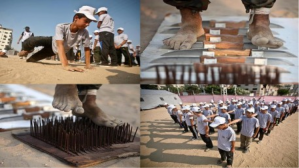No Gaga Here: Extreme Summer Camps in the Middle East
By Rebecca Borison
While I grew up at a Jewish summer camp playing Gaga, kids growing up in slightly (read: very) different areas than me are partaking in slightly (read: very) different activities in summer camp. The Times of Israel recently published two separate articles on Extreme Summer Camps. The first article discusses a Hamas-run Gaza summer camp, where “activities include walking on knives, cleaning beaches and experiencing life as a security prisoner in an Israeli jail.” Five days later, the Times of Israel released a second article about a right-wing camp in Ramat Migron, where the girls learn “self-defense techniques, how to construct temporary dwellings and basic agriculture.”
separate articles on Extreme Summer Camps. The first article discusses a Hamas-run Gaza summer camp, where “activities include walking on knives, cleaning beaches and experiencing life as a security prisoner in an Israeli jail.” Five days later, the Times of Israel released a second article about a right-wing camp in Ramat Migron, where the girls learn “self-defense techniques, how to construct temporary dwellings and basic agriculture.”
So we have two camps representing the extremes of Israelis and Palestinians. But let’s take a closer look at these camps.
We’ll start with camp “We will live honorably” in Gaza. Now that the United Nations Relief and Works Agency (UNRWA) no longer runs summer camps in Gaza, “We will live honorably” is the only option for kids in Gaza. This Hamas-run camp attracts around 70,000 kids from across the Gaza strip. According to one of the camp directors, Omar Aql, the camps try to “strengthen the importance of volunteer work and create a clean social environment.” For example, campers participated in a campaign to clean the Nuseirat beach.
But then there are some disturbing camp activities as well. Campers are introduced to a model of an Israeli security prison in order to “reenact the daily suffering of Palestinian prisoners,” according to the Palestinian Maan news agency. The “prison” consists of an investigation room, a detention room, a confession extortion room, a solitary confinement room, a courtyard and an infirmary.
At Camp “Hilltop Youth,” the campers partake in some disturbing activities as well, learning krav maga in order to fight against any Arabs that may happen to attack them. The girls are also introduced to extreme living arrangements, spending four days without electricity or running water. Unlike the “We will live honorably” camps, the “Hilltop youth” camp is one of many summer camps available in Israel. An Israeli child can have a normal camp experience at Camp Kimama or Camp Tapuz.
honorably” camps, the “Hilltop youth” camp is one of many summer camps available in Israel. An Israeli child can have a normal camp experience at Camp Kimama or Camp Tapuz.
Both camps promote the immense value of devotion to one’s people. A camper from Gaza named Abdulaziz A-Saqa explained, “We learned that Palestinian prisoners suffer greatly for the Palestinian people.” One of the campers at Ramat Migron named Esther told the Israeli Newspaper, Ma’ariv, “Whoever comes here isn’t looking to go to a luna park (amusement park), rather to fight on behalf of the State of Israel.”
Both campers have been taught to devote their lives to their nation. They are instilled with a great sense of patriotism—to the extent that they will fight no matter the cost.
While Gaza camp counselor Abdul-Ghafour denies that the camp is training future Hamas militants, it definitely appears to be a strong possibility. Why else would these campers need to learn how to “slide over thorns using his elbows for propulsion” and run and jump through flaming hoops? According to the Washington Post, the campers are “told to fight Israel to liberate Palestine.”
According to Ma’ariv, the goal of the “Hilltop Youth” camp “is to train and recruit the next generation of warriors to settle the hills.” They even bring in speakers from the settlement movement, such as MK Michael Ben-Ari and Itamar Ben-Gvir.
Yes, that sounds just as extreme as training Gaza youth to be Hamas militants, but there is one crucial difference between the two: the camps’ relationship to their nation. The camp in Gaza is organized by Hamas. As the ruling power in Gaza since 2007, Hamas is not only condoning such camps but is funding and running them. The camp in Ramat Migron, on the other hand, is run solely by extremists. According to Ma’ariv, “security forces came to the outpost tens of times and destroyed the wooden shacks that the youth had built,” but each time the youth return to rebuild it. The State of Israel is not supporting extremists. They are trying to stop them. In fact, Ramat Migron is scheduled to be evacuated by August 1.
You can make an argument that likens these two camps, and you could make an argument that contrasts the two. What it comes to at the end of the day is does the camp represent an extremist minority or an extremist people.

One thought on “No Gaga Here: Extreme Summer Camps in the Middle East”
I found so many interesting stuff in your blog especially its discussion. and it has really helped me alot. Do you have any other posts about this topic? Thanks for sharing with us.